Commerce
(A section of the NICEVILLE, FLORIDA - Online History Center)
"The
history of the world is the record of a man in quest of
his daily bread and butter"
~Hendrik Wilhelm van Loon, The Story of Mankind
OCCUPATIONS FROM CENSUS RECORDS
The 1880 Census for Boggy. In the 1880 Census, Boggy Bayou was assigned Precinct or Election District #9 and had fewer than 40 households. The primary occupation was "Farming" There were "Laborers", "Sailors" and a "Chair maker", and a school teacher. Elicia Marlow was the Miller. Some family names are: Alford, Allen, Beck, Bolton, Burlison, Crawford, Davis, Edge, Hart, Hodges, King, Lancaster, Moore, Nathey, Parker, Pippin, Saunders and Ward.
The 1900 Census for Boggy. The 1900 Census for Boggy was taken June 1st with 45 households, a population of under 200. Some of the men were at Eaton's sawmill and are listed as a separate household and counted twice. Some family names and occupations are: Armstrong, Allen, Davis, Edge, Ervin, Howard, Nathey, Sweeney, Stark, and Willingham as "Day Laborer". Households of Allen, Brown, and Burlison are listed as "Sailor" and Spence was listed as "Sawyer". Sawmill owner, Francis C. Eaton resided at DeFuniak Springs.
The 1910 Census taken for Boggy,
Florida in June. It shows an increase in population from 45 families
reported in 1900 to aabout 237 families in 1910. The shipyard, sawmill, shingle
mill and turpentine stills were the major employers. These are occupations for
some of the residents:
William Harley - Merchant, General Store
Sarah Howell - Saleswoman, General Store
J. Homer Johnson - Salesman, General Store
Brick P. Edge -
Postmaster
Amy Edge -
Assistant Postmaster
Dr. James C. White
- Physician
Captain of
Schooners: John Early, Frank Thomas, Noah Burlison, Charles Burlison, James
Burlison, Tolbert Parish, John Grantham. James Parish was Captain of Motor Boat
Sailors: Henry Davis, Jacob Early, Thomas Hudson and Fate Thomas
Shipyard Carpenters: John Sanders, John Day and Robert Parish
House Carpenters: Frank Davis, Frank Early, John Radford and James McClancy
Fishermen: Samual Lancaster, Elijah Lancaster, James Rooks, Alexander Howell,
Garner B. Anchors, Horace Johnson and Aaron Howell
Elijah R. McKee -
U. S. Forest Ranger
Alexander Browne -
U. S. Forest Guard
Daniel P. McKenzie
- sawmill Manager
Mack Archibald -
sawmill Engineer
Joseph Allen - sawmill Stenographer
Fredrick Garfield -
sawmill Millwright
James Smith -
sawmill Fireman
Rafting logs for sawmill - Henry Edwards
Some of the sawmill laborers: William Ervin, John Ervin, John Nathey, Sylvester
Spence, Joseph Dasinger, Jeff Allen, Joe Allen, Lon Allen, Lawrence Allen,
Warren Armstrong, Mat Davis, Charles Ingram, Alonzo Hicks, John Hicks, Charles
Dell, George Dell, Benjamin Dell, Jesse Rooks, Benjamin Spencer, Henry Crawfore,
Burl Spence, John Pryor, James Ramer, Oscar Burlison, Edgar Burlison and Henry
Copeland.
Boyd H. Munn,
Turpentine Still Manager
Simon Balentine -
Turpentine Still Owner and Manager
Jack Conger -
Turpentine Still Manager
Haywood Sutton -
Turpentine Still Manager
Steam mill laborers: Arthur Brown and Walker Brown
Laborers in shinglemill - Carrie Allen, Lee McClancy, Alexander Davis, Orville
Fisher
Some of the turpentine laborers: James F. Edge, James P. Edge, L. Edge, Albert
Edge, Robert Edge, William Bolton, Benjamin C. Allen, Charlie Allen, George
Allen, Vander Hallstead, Willis Wright, Henry Allen, Gus Richardson, Henry
Richardson, John Lawson, Charlie McCray, John Hall, George Davis, Jim Neel, Syl
Henderson, Fredrick Albritton, John Stevens, James Cauley, Jesse Stanley, Henry
Neel, James Nowling, Joe Brannan, Sidney Sutton, John Neal and Amos Neal.
Laborers, Public Work: James Corrida and Ellison Nathey
John F. Allen -
Proprietor of Boardinghouse
Joe Rushing - Fish
Dealer
Jesse Edge - Miller
Among those living
on their "Own Income" are: James T. Bolton, James Rooks, John Pryor, Clark
Stevens, Isaac Spence, William Sanders, William J. Nathey and George Parish
January 3-12,
1920 Census of Niceville (Precinct 14) 185 households reported.
The primary occupations are laborers at
the sawmill and turpentine farm, fishing and shipbuilding.
Fishermen: Ralph Williams, Lawrence Allen, J. B. Allen, R. L. Allen, Joe Allen,
E. A. Nathey, T. W. Edwards, A. A. Howell, W. T. Howell, T. W. Hudson, L. W.
Willingham, James Burlison, Curtis Burlison, Wilder Burlison, Ben Boone, Charles
Granthum, Otis Granthum, John Melvin, Joe Marler, Clarence Marler, Ed Marler,
William Marler, Ernest Marler, Dave Marler, Edwin Marler, L. D. Woodward, George
Destin, George D. Destin, John Destin, Dewey Destin, Leonard Destin, Homer
Jones, and J. W. Moore.
A. A. Brunson, Fish Hauler
C. G. Meigs, Fish Salesman
Sailors: H. D. McKinney, Horace Johnson, C. L. (H?)Marler, W. A. Reddick and J.
N. Reeves.
William Logan - Machinist, Shipyard
Ship Carpenters: J. R. Parrish, M. L. Hudson,
Merchants - B. P.
Edge, H. T. Helms, Ernest Teaner, W. L. Owens, W. J. Armstrong, V. F. Verbeck
and A. E. Howell
Lena May Armstrong, Sales woman, General Merchandise
James Armstrong, Garage Mechanic
Joe Edge, Automobile Mechanic
W. A. Anderson, Automobile Machinist
Lula J. Edge, Post
Office Clerk
Edward Freiwald,
Dry Cleaners
Louise Freiwald, Musician
James A. Fryer - Theatrical
A. Lamke - Artist
Mary Marshall -
Milliner
School Teachers:
Alice Allen, Mrs. M .E. Phelps, Patty Parrish, Eva Galbraith, and Mallory Barrow
G. B. Anchors -
Forest Ranger
Mary Jane Nathey -
Proprietor, Boardinghouse
Sarah E. Wright - Keeper, Boardinghouse
Colon O. Trest - Lumberman, Bayou Mill Company
J. M. Smith - Engineer, Steam Mill
J. A. Marshall - Millwright
Sylvester Spence - Manager, Sawmill
B. S. Spence - Sawyer, Sawmill
Ben Allen and Joe Allen - Sawmill Firemen
Sawmill Laborers:
G. W. Pippins, J. J. Nathey, Frank Brunson, Dallas Brunson, W. B. Spencer,
Bartlet Spencer, A. Edge, A. J. Richardson, C. T. Ward, Hinson Ward, R. E.
Nathey, Henry Davis, R. Howell, R. W. Morgan and Lee Reeves
House Carpenters: John Able, William Meuller, Jimmy Wright, P. B. Campbell, D.
McLeod, James
Parrish, T. N. Bell, C. V. Murphy, W. Allen, C. A. Tuttle, James McKinney, W. C.
Marshall, J. S. Senterfett, W. R. Senterfett, J. T. Allen, D. E. Jenne, J. D.
Dasinger, J. E. Early, B. A. Hicks, and J. R. Smith.
Charley Reed - House Painter
Curtis Martin - Superintendent of Construction
Brick Masons: James Rooks, M. G. Garrison, Earnest Harttess and Jesse Phelps.
Freight Truck Driver: M. A. McCullough, George Nathey, H. G. Gunnells and S. Rivers
J. M. Smith -
Engineer, Steam Mill
Charles Lear,
Manager Valparaiso Development Company
Evelyn Lear -
Telephone Operator
J. R. Parrish -
Ship Carpenter
B. S. Spence -
Sawyer, Sawmill
Robert J. Craig -
Railroad Agent
D. S. Lewis -
Railroad Clerk
David Spencer -
Hotel Manager
Frank Garner - Hotel Manager
Frank Lear -
Chemicals Salesman
J. B. Perrine -
President, Valparaiso Development Company
V. C. Lawrence -
Ice Manufacturer
M. N. Galbraith -
Hotel Barber
Paul Mueller -
Optician
L. L. Shaw -
Turpentine Farm Operator
J. R. Broxson -
Fireman, Steam Mill
A. J. Givens - Watchman, Dye Plant
William Bishell - Farmer, Valparaiso Development Company
James Reddick -
Stock Farmer, Valparaiso Development Company
Henry Reddick -
Stock Farmer, Valparaiso Development Company
F. B. Noble -
Manager, Valparaiso Development Company Stock Farms
L. L. Shaw - Operator, Turpentine Farm
James Reynolds - Foreman, Turpentine Farm
James Bacon - Distiller, Turpentine Farm
1930 Niceville Census: Niceville had 202 households and a population of 824 in 1930. The first census for Valparaiso, Florida was in 1930. It had 38 households with a population of 99.
Some Occupations for Niceville, Florida 1930
Census (April 4 - 10)
Public School:
Teachers - Mallory Barrow, Jonnie Ballard
School Bus Chauffeur - Sherman Howell
Medical:
Physician - William F. McGriff
Trained Hospital Nurse - Ella Allen
Hotel:
Clerk - Carlton McGriff
Telephone Service:
Operator at Central Office - Corina Howell
Post Office:
Bookkeeper - Lula J. Edge
Dry Goods Store:
Retail Merchants Dry Goods Store - Warren J.
Armstrong, Aaron Howell, Mattie Moore
Dry Goods Store Bookkeeper - W. B. Spence
Clerk Dry Goods Store - Maudie Keith
Grocery Store:
Clerks - Beulah Frazier, Edward Nathey, James Donaldson, Lucy Helms, Rebecca Helms
Food Service:
Lunch Store Laborer - Fannie Matthews
Café Managers - Cebelle Meigs, Pasco Livingston
Hair Cuts:
Barber - Herbert Frazier
Laundry:
Manager - Leonard Phelps
Laborer - Mattie Phelps
Public Utility:
Manager - Clarence Grimsley
Bookkeeper - Nina Grimsley
Forest Reserve:
Forest Ranger - S. Johnston
Forest Guards - Sill Ward,
James Brown
Laborer - William Holmes
Golf Field:
Manager - Samuel Cook
Green Tender -
Alfred Brown
Caddies - Harvey Davis, Jessie Nixon
Country Club Truck Driver - Bill Davis
Laborers - Charlie Frank, John Nathey, Willis Nathey,
James Philips, Alonzo Smith, Joe Rushing, Henry Livingston,
Ben Garrett, John
Owens, George Armstrong
Light Plant Station:
Engineer - M. Alford
Laborers -
Lester Early,
Henry Nichols, J. Levins
Real Estate:
Secretary - Martin
Herriott
Automotive:
Garage Manager - Garner Anchors
Garage Operator - John Edwards
Auto Shop Mechanics - Clyde Crosby, Joe Edge, Thomas Powell
Auto Shop Laborers - Clarence Bergen,
Dan Davis
Pool Room:
Manager - Lud Givins
Racker - Frank Reynolds
Boat Operations:
Boat
Carpenters - Martin Hudson, Columbus Thompson, Rudy Burlick, John Parrish
Boat
Operators - James Parrish, Charlie Parrish
Fishing:
Fish House Retailer- Henry Reddick
Fish Seller - Claude Meigs
Fish Plant Laborers - Marlin Davis, Jack Matthews
Fishermen - Bud Hudson, B. B. Boone, Jack Hudson, James Riggins, Ansley Edge,
James Moore, Ernie Howell, O. Moore, Albert Allen, Curtis Thomas, Jake Early,
Thomas Nicholson, Grady Early, Levi Griffin, Will Reddicks, Teller Howell, Lee
Reeves, George Barrow, Arthur Willingham, Leonard Allen, Lafayette Willingham,
Harvey Brown, Alex Atwell, Timothy Boone, Lon Allen, Thomas Scott, Silas
Reddick, Jack Richarsdson, Frankie Coon, Phil Coon.
Lumbering:
Lumber Mill: Operator - Syl S. Spence
Fireman Station Boiler - Green Adkison
Sawyer - Bartel Spencer
Blacksmith - Olive Duncan
Night Watchman - Lewis Gibson
Mechanic - John Gary
Lumber Mill Laborer - Prosper Jacquel,
Robert Adkison, Alfred Early, Rudolph Howard, Will Howard, Herman Weekley, Matt
Sweeney, Earl Weekley, James Coon, Leroy Allen, Quincy Adams, James Duncan,
Jason Cutts, Daniel Howell, Benson Walls, William Gibson, Alcus Agtorn, Alfie
Agtorn, Ira McCullough, Connie Weekley, Leamon Wise, Joe Franklin, Ben
Whitfield, Hura Saser, Bill Erwin, Jim Barrow, M. R. Ellison, C. L. Hobbs, Hiram
Burkit, D. Robinson, Walter Cuchins, Curtis Padgett, William Padgett, Burl
Spence, Walter Nelson, Charlie Gainey, Christopher Hudson, Cellestine Ward, Bill
Nelson, Allen Powell
Logging - Malberry Bolton, John Whitfield, Mead Whitfield, Jake Bullock, Miles
Gainey, Oscar Griffins, Charlie Lance
Turpentining:
Turpentine Still Manager - Charles Earnest
Retail Merchant
- Joel Helms
Woods Riders - Leonard Bush, Jerry Reynolds
Truck Drivers - Monroe
Hurley, Hughie Linton,
Chippers - George Morrell, George White, Joe Roberts,
Jessie Roberts, Mack Carter, Carr Grace, Isler Ammons, Jackson Bates, C. Davis,
Bruto Thomas, Mike Smith
Dippers - Joe Jones, Alex Ball, Charlie Reynolds, Sam
Stan, C. Bill,
Laborers - William Cathan, Herbert Weekley, A. Pippins, Mike
Padgett, Matthew Cawley, Darrell Padgett, Floyd Early, Arthur Hattan, Joe
Vinson, Will Nelson, William Thomas, John Brown
Carpenters and Painters:
House Carpenters - Zechariah
Smith, Isaac Willingham, Dave Keith, Lonzo Hicks, Jessie Senterfeitt, Wilson
Senterfeitt, James Helms, Wilburn Senterfeitt, John Allen, A. L. Helms, O. C.
Burden
House Painters - Joseph Jacquel, John Ballard, W. Frazier, Ben White
Bridge
Carpenter - Alvin Spencer
Highway Construction:
Contractor - Gunnell
Garrett
Foreman -Daniel C. Cook
Surveyors - William Burris, William Bandy,
Lester Mann
Tractor Driver - Willis Whitfield
Truck Drivers - Edward Cuchins,
Hiram McKinsey
Laborers - Stanley Elliott, Jason Cutts, Ben Allen, Joe Allen,
Albert Willingham, Melvin Adams, Walter Hall, Dewey Barnes
NICEVILLE BUSINESS LICENSES ISSUED BY WALTON CO (1914-1915)
October 2, 1914:
G.W. Pippin, Niceville, Fla., Merchant with capital of less than $1,000.
October 19, 1914
Bayou Mill Company, Niceville, Fla., Saw mill with capacity less than 10,000
ft.
November 18, 1914
B. P. Edge, Niceville, Florida, Merchant with capital of less than
$1,000.
January 2, 1915
Boggy Turpentine Company Niceville, Fla., 16 barrel turpentine still
January 2, 1915
Boggy Turpentine Company Niceville, Fla. Merchant with capital of less than
$1,000
January 11, 1915
B. H. Munn Bolton, Fla., Merchant with capital of less than $1,000.
January 11, 1915
Deerland Turpentine Company Niceville, Fla., 16 barrel turpentine still
January 11, 1915
Deerland Turpentine Company Niceville, Fla., Merchant with capital of less
than $1,000
January 11, 1915
B. H. Munn Bolton, Florida, Merchant with capital of less than $1,000
(The
Breeze, 10/28/1915)
SHIP BUILDING
Schooner Bera Attious: Among the vessels built at Boggy in 1888 was the Bera Attious, a schooner with a gross tonnage of 15, a net tonnage of 14 and a length of 41.4 and breadth of 15.0, and depth of 3.7 It had a crew of one and its home port was at Pensacola. (Merchant vessels of the United States (including yachts) By United States Coast Guard page 75)
Niceville Shipyard Photo Below: (Note: This photo from the Florida State Archives shows ship building continued up until the 1970s).
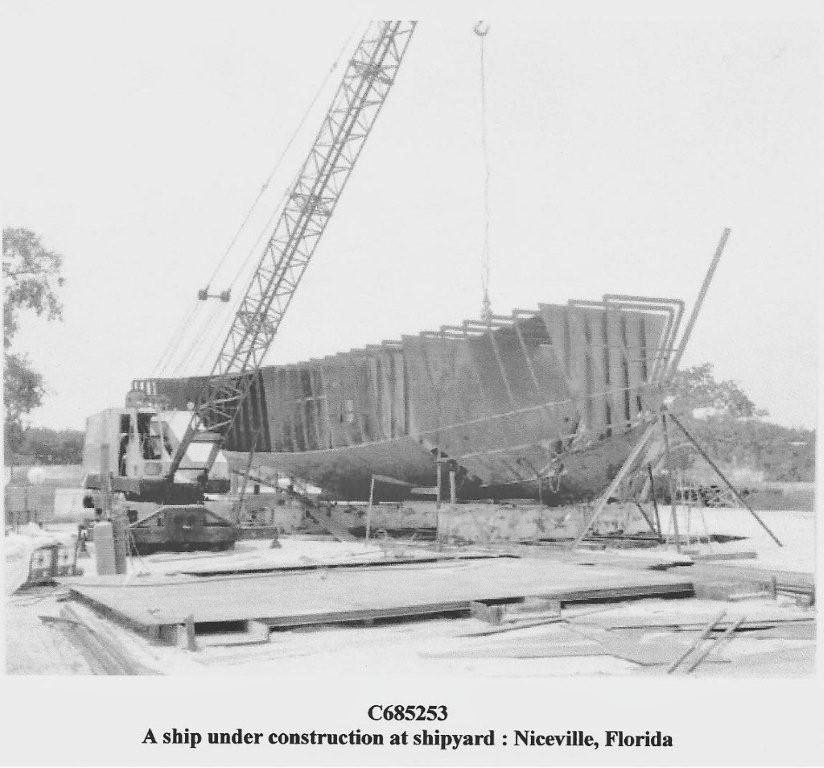
COMMERCE ALONG CHOCTAWHATCHEE BAY
In 1881 these Florida Laws were established effecting life in Boggy
Bayou:
.No. 40 Giving Concurrent Jurisdiction to the Courts of Walton and
Washington Counties over the Waters of Choctawhatchee Bay. (Florida
Law Chapter 3258 01/27/1881. Office of Secretary of State,
Legislature Attorney General)
No. 12 To establish a Lighthouse at the East Pass Entrance to
Choctawhatchee Bay, and a Beacon Light at the Entrance to Santa Rosa
Sound from Choctawhatchee Bay. Whereas, The increasing trade of
Choctawhatchee Bay and river require the usual aid from the general
Government to facilitate exportation.
No. 17 An Appropriation for Cleaning Out and Making more Navigable
the Choctawhatchee River, in the State of Florida.
The
following correspondence gives insight into the commerce on Choctawhatchee Bay in 1893.
Report
of the Chief of Engineers, U. S. Army.
Report
of Mr. J. E. Turtle, Assistant Engineer.
United
States Engineer Office
Fort
Barrancas, Fla.,
April
17, 1893.
Captain:
Pursuant to instructions of July 16, 1892, I have made an examination of the bar at the junction of Choctawhatchee Bay and Santa Rosa Sound, provided for by the River and Harbor Act of July 13, 1892, and respectfully submit the following report thereon.
This bar is situated on the west side of Choctawhatchee Bay and where it unites with Santa Rosa Sound, it is formed of compact sand with occasional oyster shells. The present channel, which is also the deepest and shortest course across the bar, is straight and bears due east from Santa Rosa Sound. This channel has a depth at mean low water of four feet, and no doubt, during much time in winter, when northerly winds prevail, a depth of several inches less than this. The channel over this bar is exposed to easterly and northeasterly winds, having a fetch of about 10 and 40 miles respectively. The water in Choctawhatchee Bay and to the eastward of this bar, is deep; therefore, during ordinary winds, there is considerable seaway in the channel; in fact, it may be said that this bar is in an exposed locality. The currents are feeble, and no doubt irregular, and can exert no influence, either in deepening or shoaling this bar. Its formation, I think, is due to action of storms, but as far as I could learn, has been permanent for a period of many years.
Santa Rosa Sound, a narrow body of water about 36 miles in length, connects Pensacola and Choctawhatchee bays. On the east side of Choctawhatchee Bay, very large lumbering industries are carried on. All of this lumber forms a part of Pensacola’s export trade, and is brought in schooners and on barges, towed by tugs, especially designed for this trade, across Choctawhatchee Bay, thence through Santa Rosa Sound and up Pensacola Bay to the shipping at Pensacola. In addition to lumber, considerable cattle, wool, wood, sheep and cotton is brought from the lower Choctawhatchee River and Bay districts to Pensacola; while Pensacola is the distribution point of supplies for the LaGrange Bayou, Lower Choctawhatchee River and all districts bordering on, and adjacent to, the waters of Choctawhatchee Bay. The commerce passing through Santa Rosa Sound and across this bar is estimated at $800,000 per annum, which I consider a fair one. While I was making this examination (one and one-half days) eleven schooners, six of them loaded, and one tow of two large barges, passed over this bar. These schooners are from 30 to 40 tons burden. During the winter months they are compelled, in order to avoid delays, to carry partial loads, while during moderately rough weather they dare not cross at all. It is a very common thing to see vessels aground on this bar; a few hours before I reached it, one succeeded in getting off, after being aground ten hours.
In view of these facts, I am of the opinion that the improvement of this bar would be of public service, and should be undertaken by the General Government.
The distance between the 6-foot curves in the direction of the channel across the bar was found to be 3,512 feet, and between the four foot curves 1,415 feet. The least depth formed was four feet at mean low water. This channel, to afford rapid and safe passage to the commerce above named, should be six feet at mean low water and have a width of 150 feet. The only means of improving this bar is by dredging.
From all I could learn regarding this bar, a channel once dredged would be very permanent.
It may be proper to report, that at the head of the “Narrows” (west end) in Santa Rosa Sound, there is one shoal crossing on which I found no more water than upon this bar in Choctawhatchee Bay. This shoal is known as the “Hurricane Crossing.” the difference being that Hurricane is in a sheltered location, and that vessels are not endangered by grounding; they are simply detained, but to give relief to this commerce, Hurricane should also be improved by dredging. A channel of 100 feet in width and five feet at mean low water would answer here.
In connection with the improvement of the bar at the junction of Choctawhatchee Bay and Santa Rosa Sound, I would recommend the improvement of Hurricane Crossing in the Narrows of Santa Rosa Sound.
Very
respectfully submitted
J.
E. Turtle, Assistant Engineer.
Capt.
Philip M. Price, Corps of engineers, USA
(Source: Annual
Report of the Secretary of War, Volume 2 By US War Dept. Appendix P -
Report of Captain Price Preliminary Examination of Bar at the
Junction of Choctawhatchee Bay and Santa Rosa Sound, FL.)
The River and Harbor Act of July 13, 1892: This allowed for Choctawhatchee Bay and the Santa Rosa Sound to be dredged making transporting products for export to Pensacola more accessible.
The Steamboat Peerless:
(Note: The photo below from 1883 is the Steamboat Peerless with bales of cotton.
It ran between Alabama on the Choctawhatchee River to Pensacola through the
Choctawhatchee Bay.)
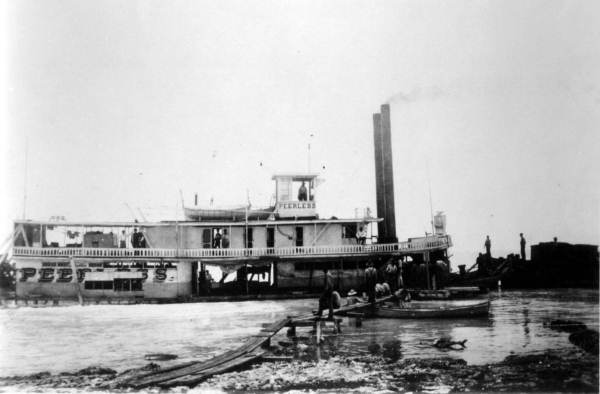
Schooner Norwich from Boggy Bayou: On May 29th 1909, The Pensacola Journal reported: Harbor River and Marine News Shipping Transactions and Notes of interest Along The Bay Front. The schooner Ruth from Gason (Garcon between Escambia and Blackwater bays) Point with 96 barrels of rosin and the Schooner Norwich from Boggy Bayou with 190 barrels arrived here yesterday their cargos being unloaded at Jefferson Street Wharf. The Jefferson Street Wharf was an open pal platform pier of pile construction used mainly for docking small bay and river vessels while discharging naval stores.
Pensacola Journal. (October 1, 1909)
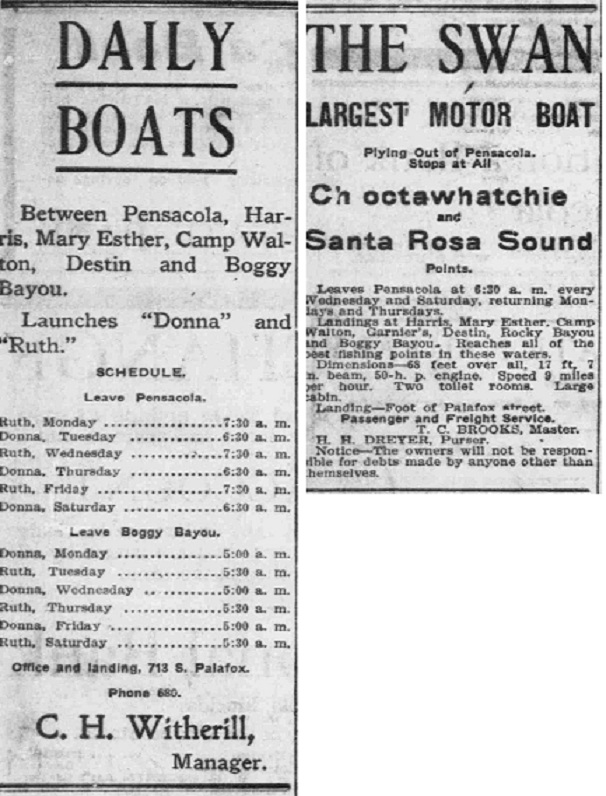
Boggy News The steamer, Belle, made its first trip in the bayou Monday, it will make two trips each week to Pensacola. (The Breeze, 09/15/1910)
The Steamer Belle Goes Down In Choctawhatchee River and Four Lives Are Lost: "River Steamer Bound to Pensacola From Vernon with Naval Stores Sinks as a Result of Severe Gale and Four Members of Crew Drown. While enroute to Pensacola yesterday afternoon the river steamer Belle, of Vernon, Fla., encountered several winds in the Choctawhatchee river, sank to the bottom and four lives were lost. The captain, engineer, and two children who were passengers on the steamer lost their lives, having gone to the bottom with the steamer. The Belle was loaded with naval stores and it is suggested that the load was too heavy for safe navigation in the fifty-mile gale which raged in this section during Wednesday. The dead: Ed Burlison, of Pensacola Captain (picture of Noah Edward Burlison on right). Charley Belle, of Vernon, engineer. Two children, names not learned. The cargo valued at five thousand dollars will probably prove a total loss. The sad incident was reported on the arrival of the Swan from Boggy Bayou this afternoon at three o'clock. The Swan brought the body of the dead captain, who was a well known citizen of Pensacola". (The Pensacola Evening News, 04/27/1911)
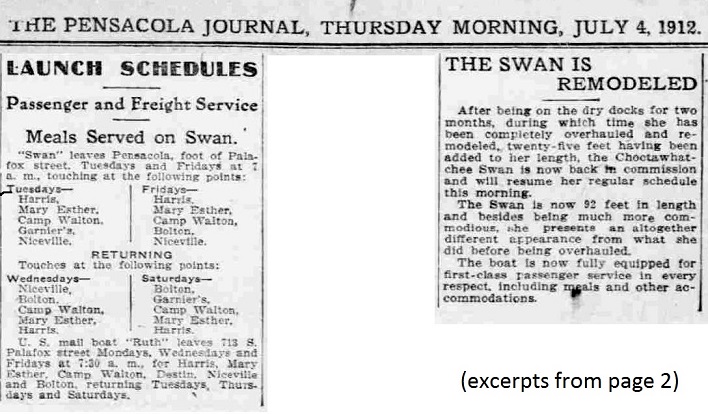
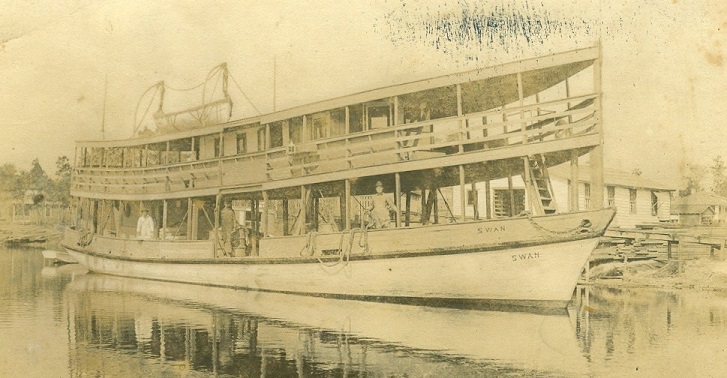
The Steamer Charles E. Cessna: A 1915 photo of The Steamer Charles E. Cessna is shown at dock loading mail and supplies. It ran between Pensacola and Freeport. Its Captain was John E. Rogers. (State Library and Archives of Florida)
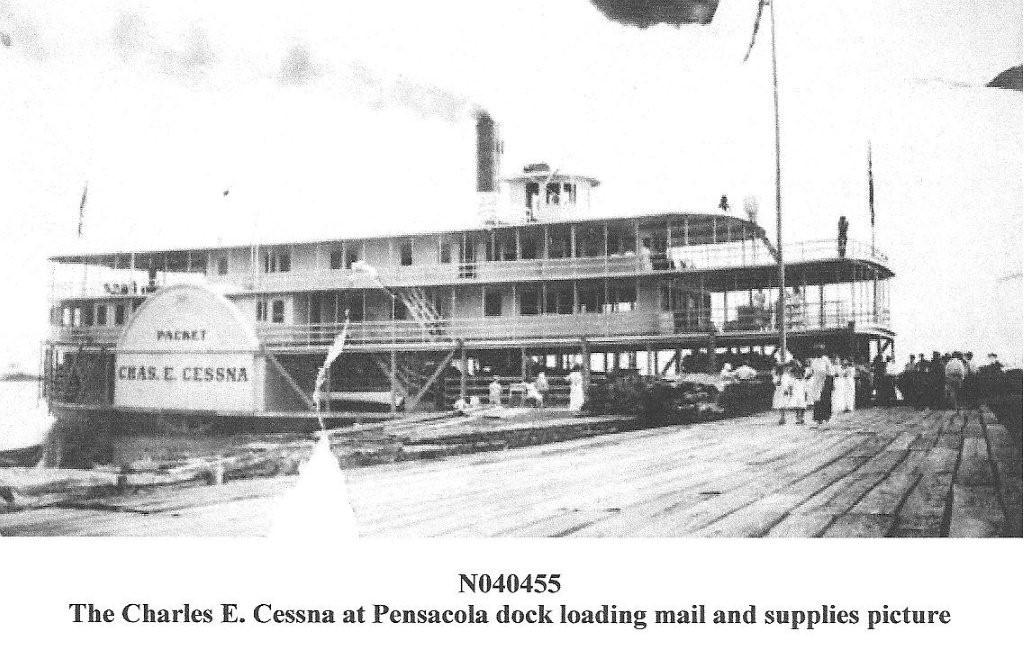
RAILROAD
The 1882 map (on this website) of the G. W. & C. B. Colton and Company map shows the Florida Transit and Peninsula Railroad and its connections. The bay is Choctawhatchee with the Santa Rosa Inlet (East Pass). Boggy is on this map. The creek at the head of Boggy Bayou is Juniper Creek.
In 1883 the Louisville & Nashville Railroad completed a 170-mile rail link from Pensacola to Chattahoochee, Florida.(Note: This opened the interior to widespread logging and the naval store industry, ended the need to ship goods down the Choctawhatchee River and on the Choctawhatchee Bay to Pensacola, brought in the tourist and opened the Bay area for speculation and development.)
Crowd Gathered for Arrival Excursion Train: Defuniak Springs, FL 1915:
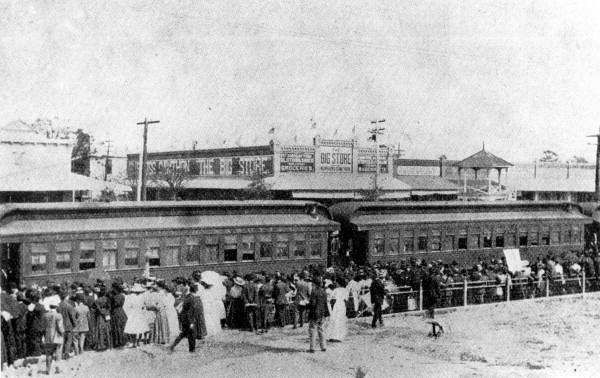
Perhaps
the railroad did not always mean progress for communities that
depended on water transportation as this account of Freeport not far
from Boggy indicates. “Previously to the building of the
Pensacola and Atlantic Railroad the town of Freeport was the port of
entry for a large portion of country surrounding it, and contained
seven flourishing stores, and considerable commerce passed through
LaGrange Bayou, but since the completion of the railroad most of the
territory formerly supplied through Freeport now draws its supplies
by way of the railroad and the Choctawhatchee River. The town of
Freeport at the time of the examination contained but one store, and
its commerce is carried on by one small schooner, which made
irregular trips between it and Pensacola." (Note: With
commerce on the Choctawhatchee Bay being reduced out of Freeport because of the
railroad, Niceville became the largest community on the Choctawhatchee
Bay.)
L & N Train on the wharf by the Wildwood Ship - Pensacola, FL. 1916:
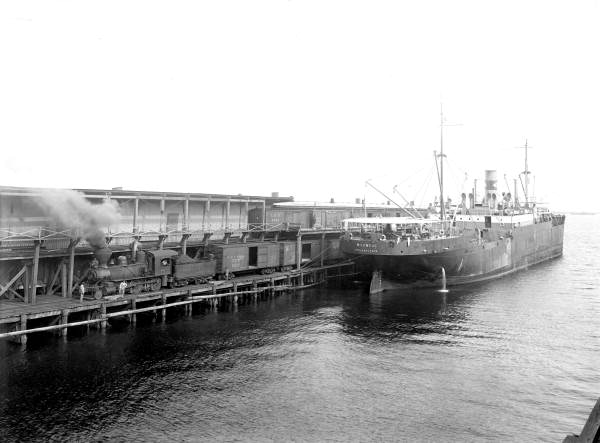
TIMBER INDUSTRY
Lumbering and Timber Exporting: Lumbering and the exporting of ship timbers are among the first industries in the country. Cypress and cedar trees that grew in West Florida made sturdy masts for sailing vessels. House shingles, a much needed commodity were made from juniper trees and pine trees were sawed into lumber. Logging, the felling and preparation of timber for shipment to sawmills, and shinglegetting – the procuring and exporting of shingles – are occupations that drew settlers to Choctawhatchee Bay in the mid-1800’s. The work was rough, dangerous and difficult. Situated about mid-way between Pensacola Bay and Freeport, Boggy Bayou on Choctawhatchee Bay, was located at the center of this busy industry and with its access to waterways, businesses grew in the local area.
B. F. Skinner from Wisconsin was one of several men with extensive lumbering interests in West Florida. Skinner brought a tugboat from Oshkosh to tow lumber and logs. He writes about his tugboat captain: “I kept him busy towing logs from Choctawhatchie Bay to the mill.”
In buying land associated with the industry Skinner wrote: “My experience in 1878 in buying logs led me to buy the log landings along the shores of the bay and river, where logs could be handled by teams and rolled into the water; then these landings could not be used without my consent while I owned them. Up to this time and for several years later, timber lands in Florida were valued at only fifty cents per acre, which price, of course, was ridiculously low. I was aware of that fact, but I think it was the general impression of the natives that these lands never would be worth more. They could secure government land by locating it under the United States Homestead law, but most of them failed to do so, because it cost fifteen or twenty dollars to locate the claim”.
In
reflecting on his experiences Skinner observed: “The pine,
at this writing in comparison with 1865, is practically exhausted. Of
course there is a great deal of it still left; enough to give
employment to lumber men for several decades; but the end is in
sight. It seems incredible that these millions of acres of pine
should have been cut off, transferred through the channels of
commerce to other claims, and so few people have been enriched by the
process”.
(Reminiscences
Friends of Pace Library website)
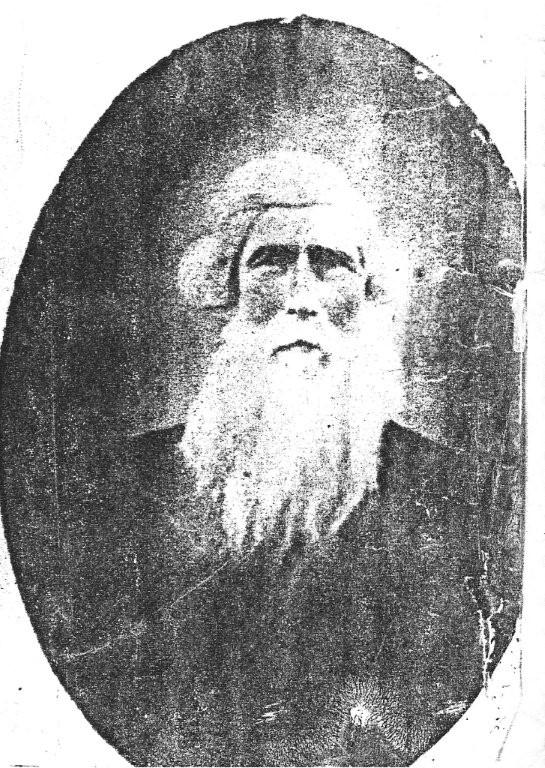
Boggy Shinglegetters:
Charles Beck (in photo ), Lee Balkam, William Nathey and William Parish,
all at Boggy Bayou were shinglegetters in the 1860’s.
Some of their descendants homesteaded there.
Timber and Mill Companies: In 1906, The J. I. Kelley Company sold more than 10,000 acres for $4,000 to D. P. McKenzie, S. S. Spence, and William Crawford, a partnership doing business as the Boggy Mill Company. On February 16, 1901, the Louisville and Nashville Railroad Company had sold this land to the Jernigan Lumber Company and on the 26th day of July 1905 the Jernigan Lumber Company sold to J. I. Kelley Co.
A. L. and Oma Langlellier of Watseka, Illinois sold more than 6444 acres to D.P. McKenzie, S. S. Spence and William Crawford doing business as the Boggy Mill Company.
Also on September 8, 1906 A. L. and Oma Langlellier of Watseka, Illinois sold more than 3220 acres to D. P. McKenzie and E. P. Rose doing business under the firm name of McKenzie & Rose. "This deed is made subject to the taxes on said lands for 1906 and subsequent years; and is also made subject to a timber lease or contract held by H. Jernigan and Sons, or their successors or their assignees". Today this land is where the Federal Prison was South of Weekly Bayou and 252.50 acres at Elliott's Point Fort Walton Beach and land north of Rocky Bayou on Eglin, also some land north of Nathey Homestead.
A. L. and Oma Langlellier of Watseka, Illinois sold to D. P. McKenzie, S. S. Spence and William Crawford, doing business as Boggy Mill Company about 6,444.66 acres in Niceville and East of Niceville
In 1907, The National Forests formed when the United States bought land from lumber companies who did not want to pay property taxes. The land would have been worthless to them after the trees were removed.

(The Pensacola Journal, Saturday
morning, 07/19/1907)
GARNIERS - The sale of the personal property of the estate of F. E. Robinson last week was very well attended, but the property did not bring a very high price, thirteen head of oxen bringing $250 and 35,000 feet of lumber was resold to Mr. McKenzie of Boggy. (excerpt from The Pensacola Journal, 07/26/1907)
In 1908, a Contract and Agreement signed between the Dunwoody-Aiken Tow Boat Company of Pensacola, Florida and J. J. McCaskill Company of Freeport, Florida stated: "The Dunwoody-Aiken Tow Boat Company agree to lighter and tow as per orders of the J. J. McCaskill Company to be given from time to time during the term of this contract the entire lumber products except what may be lightered by the Schooner "Stella E." of the said J. J. McCaskill Company mill at Ship Yard point on LaGrange Bayou the Jolly Bay Mill, on Jolly Bay, and the Kelley Mill at Portland, now under contract to the J. J. McCaskill Company, and any future contract whereby they control the output of these or any other mills on Choctawhatchee Bay now erected and operated, or to be erected and be operated and delivered same to Pensacola, Florida, as hereafter specified."
The Boggy Mill Company: Principal place of business, Walton County at Boggy Bayou, Fla. Capital stock $30,000 Filed May 26, 1908 Letters patent issued July 11th 1908 Affidavit of Treasurer that 10 percent of the capital stock has been subscribed and paid. Filed August 31st 1908 Incorporation, Stockholders: E. V. Crawford, Scarritt Moreno, S. S. Spence and B. S. Spence. Also the Consolidated Land and Lumber Company of Boggy, Florida filed for application for Letters of Patent.
The Lima Locomotive Works built for the J. J. McCaskill Co. of Freeport on November 6, 1908 the following described locomotive: Shop Number 2056 Class: B24-2 Trucks: 2 Cylinders: 3-8x8 Gear Ratio: 3.071 Wheel Diameter: 26.5 inches Gauge: std Boiler E.W.T. - 33.5 inches Fuel Type: Wood Fuel Capacity: 1.25 Cords Water Capacity: 850 Gallons Empty Weight: As built 45,000. It became the property of the Choctawhatchee Lumber Co. in Freeport, Florida, February 1911; then sold to the Southern Iron & Equipment Co. Atlanta, Georgia July 1917. It had other owners, the last one in 1937 and was scrapped.
Boggy, Special to the Journal: The Boggy Mill Company is now running its plant on full time, cutting about 21,000 board feet per day. The mill of the Consolidated Land and Lumber Co., will be ready to start up within a short time. Boggy is becoming one of the best towns in this section. The name Boggy signified that it is bogged up with business. There are about ten buildings in the course of construction and everyone is busy. New families are locating rapidly, and at the present time the town has four stores, two mills and two (turpentine stills). (The Pensacola Journal, 11/25/1908)
On December 11, 1908 H. H. Brown and J. L. Brown sold to B. H. Munn for $3500 all of their "undivided interest in the personal property owned and used by Rocky Turpentine Company in connection with their turpentine business in Walton County, Florida: One turpentine still and fixtures; Seventy five dip barrels; Four head of mules; Three head of horses; Six head of oxen; One log cart and fixtures; Two turpentine wagons and harnesses; One buggy and harness; One Cole saw mill and fixtures complete, including all the pulleys, belting, shafting, sawmill engine, boiler, etc.; One ferry boat and five skiffs. Also all the stock of crude gum as well as all manufactured products wherever located and to that certain lease for turpentine purposes executed by Jernigan Lumber Company to M. Hancock and Sons, dated September 27, 1904 and recorded in Deeds, Walton Co."
The
Consolidated Land and Lumber Company sold to G. W. Soule of Florida for
$1,375.00:
All of Sec. 30 T1S
R22W Acres: 465.20
S
1/2 & SE 1/4 of NE 1/4
Sec. 25 T1S R23W Acres: 360.56
Lot 1 Sec. 35 T1S
R23W Acres: 120.00
Lots 1 & 2 Sec. 36
T1S R23W Acres: 168.00
Total: 1,113.76
These 1,113.76
acres are along the Choctawhatchee Bay from Weekley Bayou, then southwesterly.
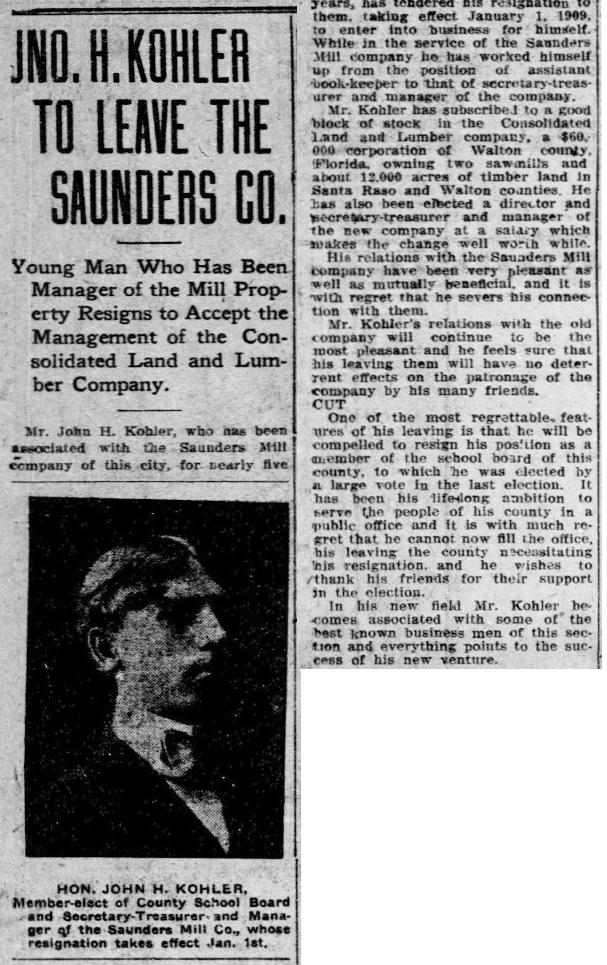 (The Pensacola Journal, December 20, 1908)
(The Pensacola Journal, December 20, 1908)
Help Wanted: A young man to run the commissary that has some knowledge of bookkeeping and using a typewriter. Only sober, steady men need apply. Consolidated Land and Lumber Co., Boggy, Fla. (The Pensacola Journal, 04/07/1909)
Tersely Told: P.A. Henderson of Boggy with the Consolidated Land and Lumber Co. is in the city enroute to his home at Muscogee to spend Christmas with his people. He will return Monday. (The Pensacola Journal, 12/25/1909)
January 4th Notice of Special Master's Sale (Eaton Saw Mill at Boggy): "Notice is hereby given that under and by virtue of a final decree in foreclosure of mortgage rendered by Honorable J. Emmet Wolfe, Judge of the Circuit Court of Walton county State of Florida in Chancery, in a certain cause therein pending wherein Pensacola Dry Goods Company, a corporation is complainant and Consolidated Land and Lumber Company a corporation and Boggy Mill Company, a corporation, respondents, wherein I was appointed Special Master to sell the property hereinafter described to satisfy the sum of $1406.22, and the costs of the proceedings, as set forth in said final decree, which was dated December 10, 1911, I, A.G. Campbell as said special master will sell before the court house door at DeFuniak Springs, Florida, during the legal hours for sale on Monday the 6th of February 1911, to the highest and best bidder for cash the following described property, to-wit: One Engine and boiler known as the Eaton engine and boiler, together with Shafting, Belting, Pulleys, Saws and all other appurtenances of the Eaton Saw Mill at Boggy, Florida. The said property being at Boggy, Florida, and under order of the court will so remain until after sale, the same being sold however before the court house door as aforesaid. Bills of sale at cost of purchasers. This January 4, 1911. A.G. Campbell, Special Master."
Boggy News. "W. M Sessions of Ozark, Alabama was down looking after his
interest in the Boggy Mill Company this week returned Friday." (The Breeze,
02/23/1911)
The Boggy Mill Company (located Lot 5 of Sec 7, Tp. 1 South, Range 22 West) sold 07/05/1912 to Rawls: The Boggy Mill Company was sold at public auction to J. P. Rawls for $7,000 as highest bidder to include all the saw mill logs now owned by the said Boggy Mill Company located in Walton County Florida or wherever said logs may be located: All of the household and kitchen furniture; all crops of every description raised or caused to be raised during the years 1909, 1910, and 1911; all farming tools and implements, all livestock and other property of the Boggy Mill Company. All rents or advances to become due to the Boggy Mill Company as landlord from any tenant in said County of Walton; One Houston S.G. Boiler; One Wheeland Boiler, One Nagel boiler, One 12 x 13 Wheeland engine, 1 - 10 x 12 Wheeland Engine, One N. 856 continental engine; Two feed water pumps with all pipes and valves and fixtures to engines, boilers and pumps; One saw mill husk, carriage and belts, one twin engine and feed. One edger and fixtures and cut off saws and mandrels and fixtures. All pulleys, belting, shafting, boxes, one slab conveyor and fixtures, one log hauler and fixtures: One shingle mill, including all belting, pulleys, shafting, boxes, conveyors, mandrels and saws; One stave machine and fixtures, half interest in the schooner “Evelyn”, also forty acres of land, more or less, upon which the mill and quarters of said Boggy Mill Company are built, bounded on the North by H. Edwards and F. Thomas land, On the east by Hyer land and on the South by G. W. Parish and Boggy Bayou and on the West by Boggy Bayou; also all logging tools, carts, chains, ropes, dogs and everything connected therewith; also all blacksmith shop and tools, including forge, drills and stock of iron, also filing room, tools, including gummers, wages, hammer, anvil and all other tools connected and used and now owned by the Boggy Mill Company; also all the circular saws now owned by the Boggy Mill Company. All of the lumber of the said Boggy Mill Company cut by it prior to January 1st 1911; All staves, heading and shingles: 67,500 shingles, 1.000 feet 3x8 and up cypress, 7,000 feet refuse cypress, 13,300 feet 2x4 and up, 5,800 feet German Prime, 4,500 feet Crown, 8,200 feet heart face, 8,083 feet Prime, 7,456 feet Genoa, 1,848 feet Rio, 65,127 feet South American and all lumber of any kind cut from time to time and stacked or unstacked by the Boggy Mill Company prior to January 1, 1911. All the lumber of the said Boggy Mill Company, including all staves, heading and shingles cut by said Boggy Mill Company and stacked or unstacked on its yards prior to January 1st 1912. (Warranty Deeds 07/05/1912) With (page 552) J. P. Rawls has 1/3 interest in land and sawmill equipment. With (page 555) J. P. Rawls acquires it all - 1/3 at a time for 1,000 each $3,000 for 6,000 acres. (Note: After the last Warranty Deed (page 558) had been successfully transacted, J. P. Rawls had acquired all property and all interest in the Boggy Mill Company and paid the indebtedness.)
Boggy Mill 40 acre complex location
(Lot 5 of Sec 7, Tp. 1 South, Range 22 West) as found on the 1908 Walton Co. Farm Map:
(Note: the Boggy Mill Co. owned 6000
acres with parcels throughout the county when sold in 1912. It is bordered 'on
the South by G.W. Parish and Boggy Bayou and on
the West by Boggy Bayou".
George W. Parrish received
his homestead on January 13, 1908, the SW quarter of the SW quarter of Section
8, the West half of the NW quarter of Section 17, and Lot 1 in Section 18 in
T1S R22W containing 147.31 acres along the water on the east side of Boggy
Bayou.)
The Boggy Mill Company sold by Rawls to McCaskill: It was sold by J. P. Rawls to The
Mutual Land and Lumber Company owned by R. E. L. McCaskill. (Walton County
Warranty Deed 10/07/1912)
Mutual Land and Lumber Company buys McKenzie Mill:
D. P. and Louise McKenzie sold to the Mutual Land and Lumber Company of Boggy,
Florida (owned by McCaskill) Lots numbered 5 and 6 in Section One T1S R23W
(located on the west side of toward the head of Boggy Bayou). D. P. McKenzie
will not for a period of twenty years from the date hereof engage in the saw
mill business in either Walton or Santa Rosa County within any territory within
a distance of fifteen miles from Boggy, Florida. (Walton County Warranty
Deed 11/12/1912)
Mutual Land and Lumber Company: The Mutual Land and Lumber
Company (owned by
R. E. L. McCaskill) sold to D. P. McKenzie, Lot 1 Section 12 in T1S of
R23W known as the Eaton Land except that part thereof that is owned by S. S.
Spence. As part of the consideration of this conveyance, it is understood that
the said D.P. McKenzie for himself, his heirs, executors, administrators and
assigns with the said Mutual Land and Lumber Company, its successors and
assigns, that he will not use the above described land, nor any part thereof,
for a period of twenty years from the date hereof, for saw mill purposes.
(Walton County Warranty Deed 12/16/1912)
Choctawhatchee Lumber Co.: The Choctawhatchee Lumber Co. (R. E. L.
McCaskill, President) sold to Charles E. Cessna of Chicago, Illinois 960 acres.
(Warranty Deed 02/09/1914)
Union Land & Timber Company: The Union Land & Timber Company of
the State of South Dakota, having its principal place of business in the Parish
of Orleans and State of Louisiana to: The R. E. L. McCaskill Company - All of
fractional Section 16 T1S of R22W, containing 268.33 acres. (Walton County
Warranty Deed 05/14/1918) (Note: This land is
located on Rocky Bayou in Niceville. McCaskill sold it to John B. Perrine
04/06/1921 and it is possibly the only land purchased by John Perrine in
Okaloosa County. His wife, Mary Perrine and Leslie Frank Perrine and Charles
Perrine were deeded property from William L. McCollom in Valparaiso.)
McCaskill
Buys Union Naval Stores Land: "R. E. L. McCaskill has purchased the Okaloosa county holdings of
the Union Naval Stores company of Mobile. This property consists of around
67,000 acres and lies in the Southwestern part of the county. It is said it is
the intention of Mr. McCaskill to turpentine and sawmill this tract. J. J.
McCaskill dealt in this same tract a number of years ago. Twenty-four hours, as
the story goes, after securing an option on it, he sold it to the Union Naval
Stores Company at a profit of $63,000. Now his son buys it from the naval store
people. Bob is lucky, and will doubtless do better than his father." (The Okaloosa
News Journal, 11/21/1919)
Boy Crippled in
Sawmill: "A 12 or 13 old son of S. S.
Spence met with a painful accident in his father’s sawmill, at Niceville, last
Thursday. His right hand was cut by a saw, and Drs. McGriff and Webb found it
necessary to amputate the forefinger but saving the thumb and other fingers."
(The Okaloosa News Journal, 04/09/1920) TURPENTINING
In 1905, a
turpentine lease was signed September 30th
from Francis C. and Mary Eaton to McKenzie and Rose, for the following land
located today in Valparaiso, Eglin and Shalimar. 465.20 acres on Eglin
South of Weekly Bayou on Choctawhatchee Bay; 80 acres (Juniper Creek runs
through this land and is just North of the Nathey Homestead.); 40 acres (on
Eglin); 39.98 acres (on Eglin - North gate on this property); 40 acres (in
Valparaiso, FL and Eglin); 40.25 acres (on Eglin just West of Valparaiso, FL);
40.11 acres (On Eglin, Tom's Creek runs through it); 360.56 acres (Eglin Blvd.
runs thorough it on Eglin); 120 acres (on Eglin on Choctawhatchee Bay); 168
acres (on Eglin on Choctawhatchee Bay); 240.45 acres (Port Dixie - East of
Shalimar); 165.75 acres (Snug Harbor, Shalimar). In all 1800.30 acres.
(521.12 acres in
today's Santa Rosa County). Also all of the timber, except the cypress and
juniper timber upon 119.97 acres, an additional 119.97 acres, 400 acres, 379.80
acres, and 40.08 acres. This land lies just North of Valparaiso and Nathey
Homestead in Niceville. Eaton’s land was on either side of Juniper Creek
(today's Turkey Creek). Today this property is on Eglin. In all 1179.79 acres.
The total sum containing 3,501.21 acres lying and being in the Counties of Santa
Rosa and Walton, State of Florida. "Together with the right to cut and remove
the said timber, box, chip, scrape and work the same for turpentine purposes at
any time prior to the 16th day of February 1911, as well as the right
to ingress and egress in to from and on the same for the purposes of
constructing any buildings, roads, and ditches that may be necessary for the
proper marking and removing the said timber. This instrument is intended to be
and is a transfer of all the right, title and interest in and to the lands, and
timber hereinbefore described and which more conveyed by R. G. Peters and the
L&N Railroad Company on the 16th day February 1901 to the Jernigan
Lumber Company and by the said Jernigan Lumber Company to the said F. C. Eaton
on the 20th day of April, 1904. This instrument is made subject to a
lease granted by the said Jernigan Lumber Company to Allen B. Brown on the 12th
day of June 1903 in which the right is given to remove at any time within four
years from the date of said lease certain dead pine and oak wood from the said
Sections 30 T1S R22W (South of Weekly Bayou on Eglin on Choctawhatchee Bay) and
these parts of Sections 25 (just North of Section 36), 35, and 36 of T1S R23W
(on Eglin on Choctawhatchee Bay)."
Turpentine Lease 1907: (Note this lease between
William John Nathey and his wife Mary Jane Bolton Nathey with D.P. Mckenzie &
E.P. Rose was their homestead land at the head of Boggy Bayou. William John
Nathey was born on this land on June 22, 1846. He homesteaded the land in 1903
while it was still part of Walton Co. He died in 1916. She died September 19,
1922. Some of their homestead was sub-divided in 1926 as the Florida Heights
sub-division and the remainder in 1927 as the Nathey Estates sub-division.)
The Boggy
Turpentine Company: E. P. Rose and S. W. Balentine partners in The
Boggy Turpentine Company, leased from D. P. and Louise McKenzie for $1,620 the
following land for turpentine purposes:
Garniers:
Workers Gathering Turpentine: Note: Naval stores
operation during the late 1920's in Choctawhatchee National Forest.
Niceville Ballots On Incorporation: "J. M. Reynolds (a turpentine foreman
from Louisiana) Is First Mayor As Council Meets:" (The Okaloosa News Journal,
07/15/1938)
NICEVILLE HOTEL Niceville News, The Okaloosa News Journal,
06/21/1918
(left) and 07/12/1918 (right): (Note: Mrs. McCaskill
of DeFuniak Springs purchased the Niceville
Hotel in June 1918 and as reported on July 12, 1918 in the Okaloosa News
Journal sold it shortly to Mrs. Gewan. "Mrs. Gewan from up North, is now
proprietor of Niceville Hotel and is getting along nicely with a number of
tourists." Also note that Mrs. Butler from DeFuniak was staying at the
hotel for the summer.
The hotel was later named Valparaiso Hotel.)
The first proposed plat of Niceville drawn November 21, 1918 and filed
March 24, 1920 showing Niceville Hotel (see The Okaloosa News Journal,
06/21/1918 and 07/12/1918 ) and Nathey Gristmill at Trout
Lake. (Note: The McCaskill’s owned land along Rosson Branch and
he was
developing Boggy Bayou (For marketing purposes he referred to it as Valparaiso Bay). Mrs. McCaskill
bought the Niceville
Hotel that was later marketed as the Valparaiso Hotel.
GENERAL MERCHANDISE
Niceville: "Edge and Spence are now occupying the new
building down at the water edge and their stock looks much better in the new
quarters." (The Breeze, 12/12/1912)
Niceville: "Mr. W. N. Hartgrove of Garniers made a speech at the Shaw and
Sessions store Saturday night." (The Okaloosa News, 11/10/1916) Edge and Armstrong Store, Niceville:
(Note: Advertisement as written)
==Appetite Builders =:= We Have Them! No, they are not drugs. You don’t need
drugs to promote a good appetite. You need Pure, Fresh, Full Strength Groceri's
and that is just what you will find, alwas, at our store. We are especially
careful at this time to offer our customers no food that will not bear the most
severe tests of PURITY, FRESHNESS & STRENGTH. Always come to us for foods that
will return you 100 per cent efficiency in strength & vitality. B. P. EDGE &
WARN ARMSTRONG, Niceville, Florida.Edge & Armstrong, General Merchants
Niceville, Florida, CARRY THE LARGEST & BEST STOCK IN THE COAST COUNTRY. They
hammer prices down to the lowest point. THEIR STOCK IS FRESH & DEPENDABLE It
will pay to motor miles to trade with them. COME AND SEE US, PURCHASE AND RETURN
HOME HAPPY. EDGE - ARMSTRONG GRESTEST GENERAL STORE in the Coast Country.
(The
Okaloosa News Journal, 05/30/1919)
Edge and Armstrong Store, Niceville:(Note: See store ad dated 04/09/1920 regarding the
location of the store.) "Edge and Armstrong Store Valparaiso,
Florida, Carry a complete line of staple Dry Goods, Dress Goods, Notions, Laces
and embroideries; Ladies', Misses', Men's and Boys' Hats; A complete line of
shoes for the entire family; heavy and fancy groceries; cigars and tobacco."
(The Okaloosa News Journal, 09/19/1919)
Mr. B. P. Edge Again Making Money: "For several years Mr. B. P. Edge
conducted a general merchandise business in the town of Boggy, and made money.
Later the name was changed to Niceville, and is a part of the town of
Valparaiso. Mr. Edge retired a few years ago, and the town of Niceville lost its
fame as a merchandise center. Since the town became part of Valparaiso, Mr. Edge
is again making money in the Niceville section, and can be found waiting on his
friends and customers. He has a congenial partner, Mr. Warren Armstrong, who has
many friends. Mr. Edge is one of those men whom it is a pleasure to know, and
when he comes up to Crestview, as he did this week, his arms got sore from
shaking hands. He declared Tuesday that he would have to return home, not
because he wanted to, but as a matter of self protection, or his good right arm
would be still for a week. As he stood on the front porch of the court house,
the News-Journal news gatherer could not but help notice that every man who came
to the courthouse - and it was county court day, and many came - knew Pomeroy
Edge. The News-Journal news gatherer was in Mr. Edge's store a few days go, and
could not get a chance to say "Howdy," not liking to but in. But when we met Mr.
Edge in Crestview he caught particular fits for not butting in, hence this
statement of facts in order to square himself. Some day the News-Journal news
gatherer will go down to Mr. Edge's store, sit out on the gallery, look out over
the beautiful water view, and smoke up every dogon cigar Mr. Edge has in his
store, and tell Mr. Edge they will be paid for when the news gatherer kills his
hogs, which will be several years from now. If ever. Of course it will be all
right with Pomeroy, for many of his friends have pulled off worse stunts than
that, for if they had not Mr. Edge would be better off in this world's goods.
When you go down his way, make a call, and you will meet two genial men when you
cut in on Messrs. Edge and Armstrong." (The Okaloosa News Journal, 12/19/1919)
(Okaloosa News Journal, 04/09/1920)
Advertisement for Edge & Armstrong General Merchants Niceville, Florida:
Greatest General Store in the Coast Country (The Okaloosa News Journal,
01/07/1921)
LL. Shaw, Niceville Advertisement on left: (The Okaloosa News Journal,
04/08/1921)
Niceville and Finck Are Same: "Business
Concentrates Around Pioneer Establishment: The destructive fire which recently
almost obliterated the business section of Niceville, had very little effect on
the business life of Niceville. The activities of nearly an entire block simply
concentrated in Finck’s Restaurant, and business went along. It began on the
morning of the fire. While the ruins were still smoldering, space was being made
in Finck's for the post office. During the day the Niceville Fish Company set up
offices there. Within a little while a grocery had been added. And now Adolph's
establishment represents the bay country's first and only complete arcade. In it
is found a post office, a wholesale and retail fish house, a grocery, a
restaurant, a bakery and the bay country's only draft beer dispensary, while the
Niceville Masonic Lodge occupies the floor above." (The Valparaiso Star Vol. 12
#41, 02/01/1934)
New Edge Store:
The appellee's testimony confirmed the admissions made in his bill. The fire,
which in 1933 destroyed the Edge store building, also destroyed a fish house
near the shore line which is the south boundary of block 18. The appellee had
been occupying the fish house as a tenant of the Bayou Fish Company. The
evidence indicates that the fish house had been located on lot 2; but its
location before the fire is of little or no importance. After the fire the
appellee built, in 1934, a new fish house, the length of which along the shore
was approximately twice the length of the old building. The appellee testified
that the new building "overlapped" the lot on which the Edge store building had
been located and that he "made a deal with Mr. Armstrong at the time * * * and I
agreed to lease his part." The lease agreement, dated March 1, 1934, was that he
should pay the lessors (Joe Edge and Jessie Alma Edge, his wife, Lula Edge, and
W. J. Armstrong and Lula Armstrong, his wife) $100 cash, and $100 on March 1st
of each year for five years and that, as a part of the consideration, W. J.
Armstrong (who was the local postmaster) should be furnished rent free space in
the new building for use as a post office. The agreement was effectuated, the
rental was paid and the westerly end of the building was used (for some time
prior to W. J. Armstrong's death) as a post office. The appellee further
testified that he discussed with W. J. Armstrong before his death, and with
members of the Edge-Armstrong family after his death, "a trade" (which, however,
was not consummated), in which he was to "give them title to three lots over
across the road * * * for title to that portion of lot 1 that my building
occupied." (Source: SUPREME COURT OF FLORIDA, DIVISION A, July 30, 1954
- PORTER ET AL v.
MEIGS)
FISHING
Niceville: "Quite a lot of fish wagons are here from
Alabama and the northern part of our state awaiting fish. Catchers say the fish
have simply struck on them." (The Breeze, 09/26/1912)
Niceville:
"Claude Lathinhouse made his usual trip to the Bayou this week after
fresh fish and oysters." (The Okaloosa News Journal, 03/24/1916)
Niceville:
"All the fisherman are wearing broad smiles over big catches recently. They
caught seven thousand and five hundred pounds last Saturday."
Destin: "Fishing
has been very poor the past week, there being only about 13,000 pounds of
mackerel and 2,000 of Sea Salmon caught, the entire lot was bought by Mr. Claude
Meigs of Niceville. We are very glad to have a market so close by and a man
capable of handling our business. Mr. Ralph Williams and crew all went to
Niceville for church service Easter and they report a nice trip and good
service. Edwin and Charlie Marlow carried Cpt. George S. Marlow to Niceville
Sunday evening from which place he went to the county Hub of Okaloosa on some
very important business." (The Okaloosa News Journal, 04/25/1919)
McCaskill conveyed land to the Bayou Fish Company, April 9, 1920:
The R.E.L. McCaskill Company, by its deed dated April 9, 1920, conveyed to the
Bayou Fish Company "block eighteen (18) according to the plat of Niceville,
Florida, on file in the office of the Clerk of the circuit court of Okaloosa
County"; but, as expressed in the deed, it was the grantor's intention, despite
the reference to the plat, "to convey all land south of hard road and along
shore line adjoining Edge's new store building on the west and E.J. Friewald's
line on the east." (Source: SUPREME COURT OF FLORIDA, DIVISION A, July 30, 1954
- PORTER ET AL v.
MEIGS)
Catching Fish in Gulf Off Okaloosa Coast: "Mackerel are being brought by
the boatload into Niceville. The weather has been rough and fishing has not
reached its crest, but fish of all kinds are being caught plentifully. Mackerel
are especially fine, and many people motor to Niceville and buy fish "right out
of the water." The new ice factory at Niceville is nearing completion, and soon
it will be made there in large quantities. This will be a boon to fisherman for
it will no longer be necessary to ship ice. The fishing industry in Okaloosa is
only in its infancy, but the success made by those engaged in it is just a hint
of what can be done on this coast. On the East Coast there are millions
invested, and the same fish are as plentiful in the Gulf off Okaloosa coast as
in the Atlantic off Fort Pierce, Stewart and other points. The only reason the
industry is not as large is that we have not talked about our fishing
opportunities like the people of the East Coast have theirs. It is the same as
with other opportunities in Okaloosa. We do not talk enough about them. As old
Josh Billings used to say: "He that does not toot his own horn the same will not
be tooted." Josh was some philosopher, even if he did write his proverbs half a
century ago. Vesuvius would never have had a cano if he had not supported, and
got on a rampage and covered up Pompeii, almost nineteen hundred years ago -
buried the city so deep that man never has been able to dig it all out. "A city
set on a hill can not be hid", and "Do not place your light under a bushel,"
were uttered by the greatest man ever on earth, "if indeed it be lawful to call
Him a man." (The Okaloosa News Journal, 04/16/1920)
Nice News From Niceville: "Mr. G. W. Goss, Pensacola,
purchased the Bayou Fish Company last Wednesday." (The Okaloosa
News Journal, Crestview, Florida 11/20/1931)
Freezing Ice For the Coast People:
(The Valparaiso Star, Vol. 12 #41,
02/01/1934)
(Note: This ice factory for the Bayou Fish Company of Niceville is the
first ice factory in Okaloosa County.)
Fast Forging
Ahead, City Council of Niceville is Seeking Large Development: "We learn that application has already
been made to secure a PWA loan and grant for the purpose of erecting a cold
storage and ice plant. According to R. G. Patterson, consulting engineer of the
Niceville City Council, this plant when completed will have cold storage
facilities for 300,000 pounds of fish and be prepared to manufacture 25 tons of
ice daily. The estimated cost of the cold storage and ice plant is $70,000.
Commercial Fishing Operations: "Niceville is the base of
commercial fishing operations in the Gulf which furnish fish to the inland
cities of the North." (Excerpt from Florida National Forests, United States
Department of Agriculture Forest Service, F.A. Silcox, Chief, U.S. Government
Printing Office, January 1, 1939, page 22.)
Bayou Fish Company conveyed land to Mildred Plew Meigs,
May 16, 1939: By a deed dated May 16, 1939, the Bayou Fish Company
(which had been dissolved), through its surviving directors and trustees,
conveyed to Mildred Plew Meigs "the west fifty feet of lot 3, block 18, of
Niceville as shown and designated on plat 5 of the City, of Valparaiso, said
plat being on file in the office of the clerk of the circuit court of Okaloosa
County, Florida, the said westerly 50 feet of said lot being all that parcel of
land lying south of Main Street and between the property of the Gulf Power
Company and the property of W. J. Armstrong." The plat referred to is the same
plat mentioned in the prior deed; the street referred to is the hard road
mentioned in the prior deed; and the property referred to as that of W. J.
Armstrong is the same property as that on which "Edge's new store building" had
been located at the time of the execution and delivery of the prior deed. (Source: SUPREME COURT OF FLORIDA, DIVISION A, July 30, 1954
- PORTER ET AL v.
MEIGS)
Niceville, Florida: "Directly across
the bay from Valpariso is the thriving little community of Niceville. It bears
the distinction of being one of the earliest settlements in Okaloosa County and
has for many years been the center of the commercial fishing industry of the
Choctawhatchee Bay region. In fact the industry is the basis of the community's
prosperity and many thousands of dollars are annually paid to fishermen and
plant employees. The Niceville Fish Co., operated by Mr. Claude Meigs, and the
Spence Bros. Fish Co. are the leading commercial fishing industries and maintain
pretentious fish warehouses and fleets of fishing boats. Niceville has a
substantial business background, practically all lines of retail business being
represented. Here also is located the High School of the southern section of
Okaloosa County. The CCC maintains a large encampment just outside of the limits
of the city. There is much historic background also in and around Niceville one
being that of the story of an old mill built prior to the Civil War and which is
still located on the Golf Course of the Valpariso Country Club, which is
adjacent to Niceville." (Source: The Valpariso News and West Florida
Review, 12/20,/1939)
Niceville: (Source: The Valpariso News and West Florida Review,
02/22/1941)
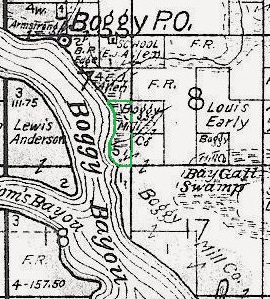
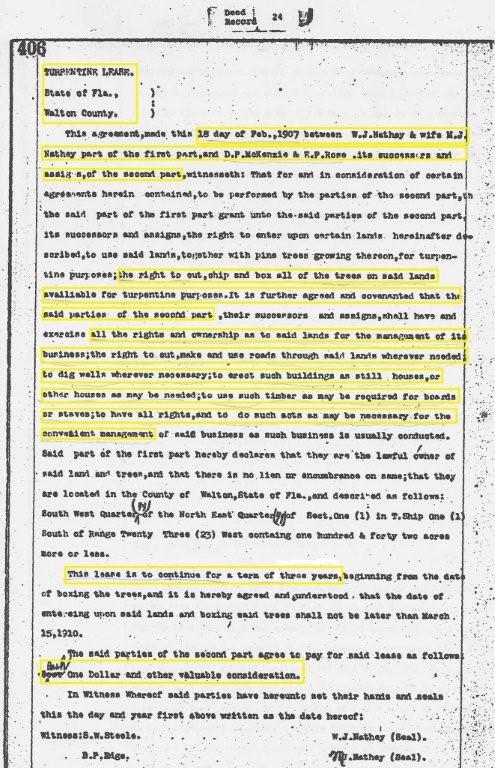
SW
1/4 of SE 1/4 Section 8 T1S R22W (At Niceville’s Palm Plaza)
N
1/2 of SE 1/4 and Lot 1 Section 17 T1S R22W (In Niceville between Boggy Bayou and
Rocky Bayou)
Lots 1 and 2 Section 20 T1S R22W (At Shirk Point on Choctawhatchee Bay between
Boggy Bayou and Rocky Bayou)
Lots 1 and 2 Section 21 T1S R22W (On Rocky Bayou at Choctawhatchee Bay)
Lot 3 Section 7 T1S R22W (The location of Old Town Niceville - near the Front
Porch restaurant location.)
Lot 2 Section 18 T1S R22W (spans Boggy Bayou Lewis Middle School is on the
Valparaiso side.)
Lots 5 & 6 Section 1 T1S R23W (the Bayou Plaza at the West side at the head of
Boggy Bayou)
N
1/2 of N 1/2 Section 3 T1S R23W (about 2 miles west of the head of Boggy Bayou on
Eglin)
S
1/2 of NW 1/4 and N 1/4 of SW 1/4 Section 4 T1S R23W (on Eglin)
W
1/2 of NW 1/4 and SE 1/4 of NW 1/4 and Lots 1, 2, 3 & 5 Section 12 T1S R23W (The
Valparaiso City Hall and Library)
N
1/2 of SW 1/4 and NW 1/4 of SE 1/4 Section 25 T1S R23W (at Eglin South of Valparaiso)
SE 1/4 of Section 27 T1S R23W (Eglin Commissary located on this property)
For the term of three years from the first day of December 1912 and the
following described property to wit:
N
1/2 of N 1/2 Section 6 T1S R23W (on Eglin just North of Peel Field)
All Section 31 T1N R23W (on Eglin one mile North of Peel Field)
NW 1/4 Section 32 T1N R23W (on Eglin)
For the term
of four years from the first day of December 1912, together with the right to
cup, back-cup, chip, scrape, dip and otherwise use the pine trees upon said land
for the purpose of extracting and harvesting the crude turpentine, there from,
together with the right of ingress and egress to, from and over the said land
for turpentine purpose for and during the respective terms upon the said tracts
of land respectively. (Walton County Warranty Deed 12/01/1912)
(Note: The turpentining process began by cutting a
series of streaks chipped one above the other and 1/4" to 5/8" of the wood
removed up the tree. Then a bucket was placed below the streaks to catch the
resin. This process was done from March - November. During the other months the
tree would be dormant.)
"I. F. Eldridge, supervisor of the Florida
Division National Forest Reserve, and Mr. Potter of Washington D. C. who is the
chief inspector of the forest turpentine industry have been at "Camp Pinchot."
Garniers, looking after business through the Choctawhatchee reservation. S. S.
Spence of the Boggy Lumber Company of Niceville, carried out a tow of logs from
the head of Garniers Bayou last Friday morning." (The Okaloosa News
Journal, 04/30/1916)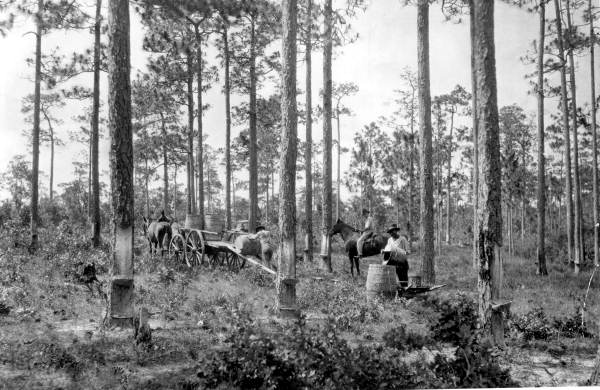
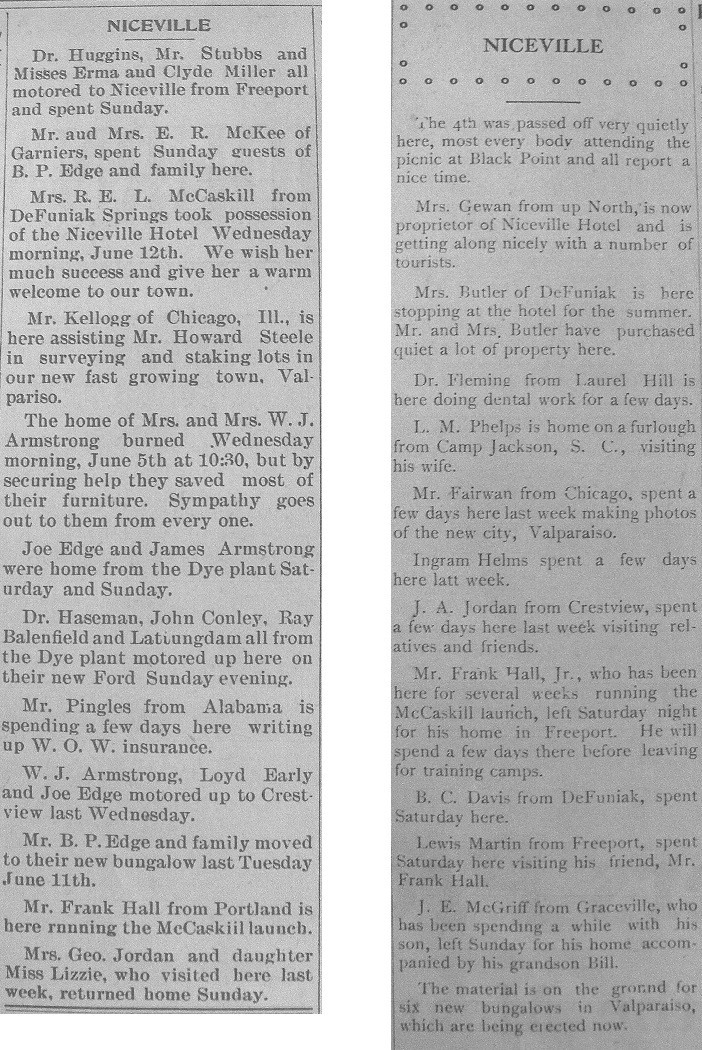
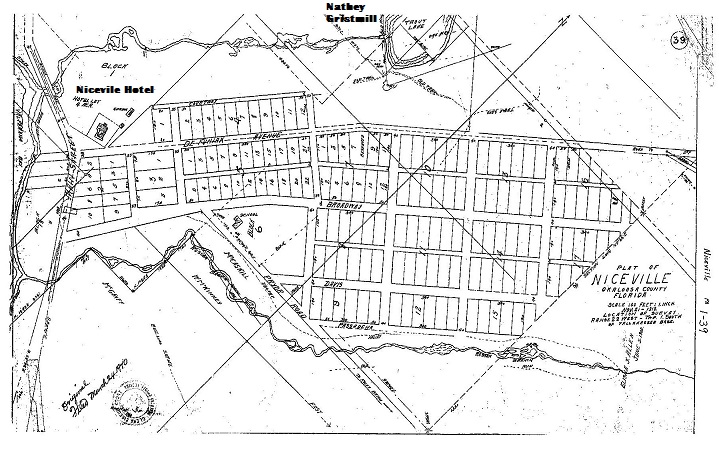
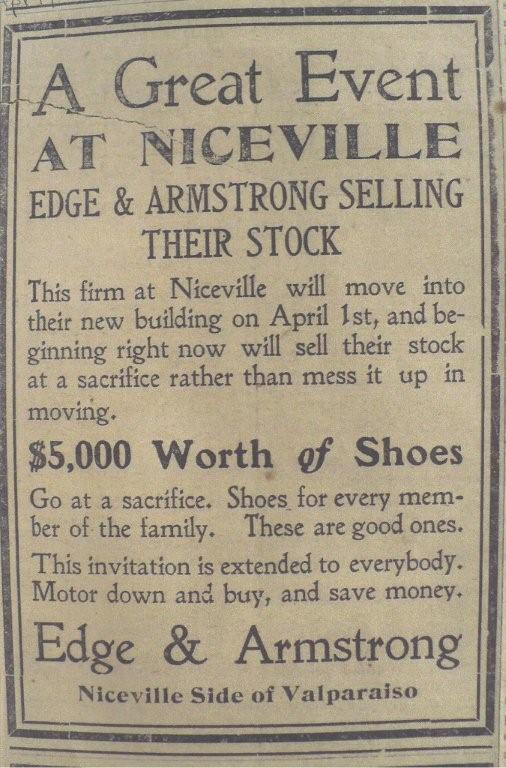
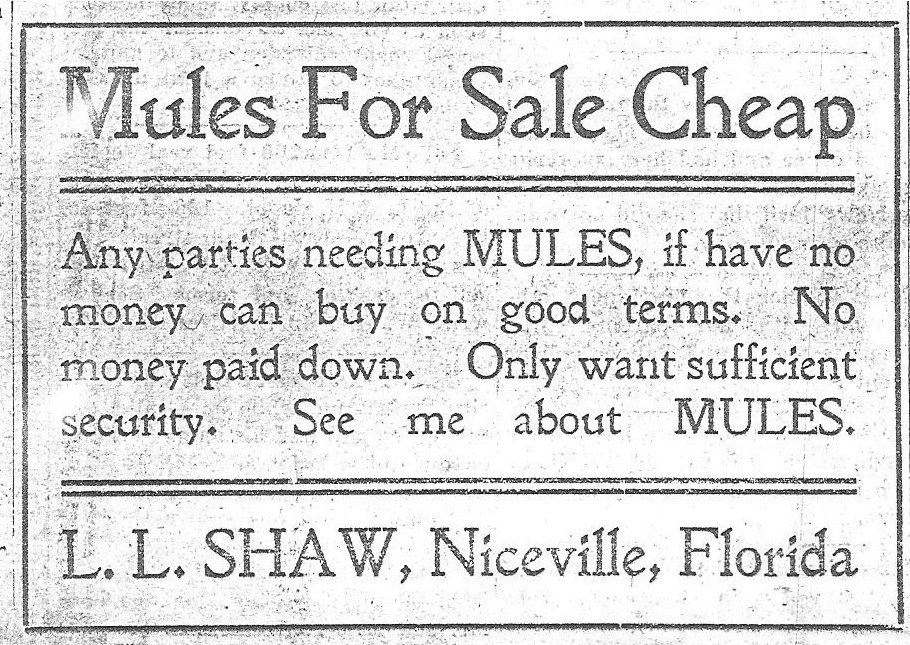
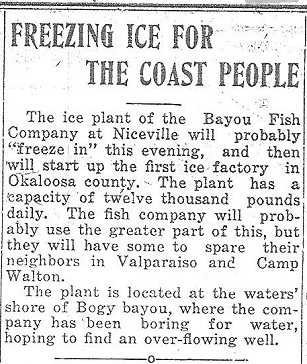 Niceville
Ballots On Incorporation: "No
longer the fishing village of other days, Niceville, with a
population of 1500 people within its corporate limits, is now
numbered among Northwest Florida’s enterprising towns. An
election held last week showed overwhelming sentiment for a proposal
to incorporate. The vote was 329 to 4......Starting from scratch, with an
enterprising group of officials which would do credit to any of the towns in
Northwest Florida, Niceville expects to build up to municipal status as rapidly
as possible. A town water system and a cold storage plant for the benefit of the
town’s all important fishing industry, are slated for first consideration."
(Okaloosa News Journal, 07/15/1938)
Niceville
Ballots On Incorporation: "No
longer the fishing village of other days, Niceville, with a
population of 1500 people within its corporate limits, is now
numbered among Northwest Florida’s enterprising towns. An
election held last week showed overwhelming sentiment for a proposal
to incorporate. The vote was 329 to 4......Starting from scratch, with an
enterprising group of officials which would do credit to any of the towns in
Northwest Florida, Niceville expects to build up to municipal status as rapidly
as possible. A town water system and a cold storage plant for the benefit of the
town’s all important fishing industry, are slated for first consideration."
(Okaloosa News Journal, 07/15/1938)
The building of this plant is a necessity in the retaining of the little city's
principal industry; Commercial fishing; in addition to lessening cost to the
fisherman, who now must ship excess product to other points for storage."
(The
Valpariso News and West Florida Review, 08/15/1938)